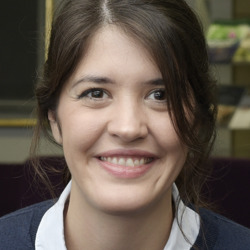Biography
Natalia Ares works on experiments to advance the development of quantum technologies, with a focus on artificial intelligence for quantum device control and quantum thermodynamics. She joined the Materials Department at the University of Oxford in 2013. She was awarded a series of fellowships, including a Marie Skłodowska-Curie and a Royal Society University Research Fellowship, and was awarded a European Research Council Starting Grant in 2020. During her PhD she focused on silicon-based devices for quantum computing at CEA Grenoble, France. She completed her undergraduate studies in Physics and a Masters equivalent in the theory of quantum chaos at the University of Buenos Aires, Argentina, where she was born and raised.
Research Interests
Natalia's research is in novel approaches to advance the engineering of quantum processors. To unleash the potential of quantum technologies, the intrinsic variability between individual devices has so far been a major hindrance.
For large arrays of devices, the tuning required to account for this variability quickly becomes an intractable task, presenting a bottleneck for the realisation of large quantum circuits. Natalia's group develops novel machine learning algorithms able to control complex quantum circuits in real time.
Natalia is also interested in the thermodynamics aspects of quantum information processing. The group fabricates devices at nanometre scales and holds them at millikelvin temperatures to explore the link between information and thermodynamics in the quantum world. Their exploration of information thermodynamics in the quantum arena will inform the construction of autonomous quantum machines such as quantum engines and quantum circuits with learning capabilities.
Current Projects
- Machine learning for quantum device control.
- Thermodynamics of quantum information processing.
Research Groups
Recent Publications
Stability of long-sustained oscillations induced by electron tunneling
Tabanera-Bravo J, Vigneau F, Monsel J, Aggarwal K, Bresque L et al. (2024), Physical Review Research, 6(1)
BibTeX

@article{stabilityoflong-2024/3,
title={Stability of long-sustained oscillations induced by electron tunneling},
author={Tabanera-Bravo J, Vigneau F, Monsel J, Aggarwal K, Bresque L et al.},
journal={Physical Review Research},
volume={6},
number={013291},
publisher={American Physical Society},
year = "2024"
}
High-fidelity spin qubit operation and algorithmic initialization above 1 K
Huang JY, Su RY, Lim WH, Feng M, van Straaten B et al. (2024), Nature, 627(8005), 772-777
Bridging the reality gap in quantum devices with physics-aware machine learning
Craig DL, Moon H, Fedele F, Lennon DT, van Straaten B et al. (2024), Physical Review X, 14(1)
BibTeX

@article{bridgingthereal-2024/1,
title={Bridging the reality gap in quantum devices with physics-aware machine learning},
author={Craig DL, Moon H, Fedele F, Lennon DT, van Straaten B et al.},
journal={Physical Review X},
volume={14},
number={11001},
publisher={American Physical Society},
year = "2024"
}
Looping in the Human: Collaborative and Explainable Bayesian Optimization
Adachi M, Planden B, Howey DA, Osborne MA, Orbell S et al. (2024), Proceedings of Machine Learning Research, 238, 505-513
BibTeX
@inproceedings{loopinginthehum-2024/1,
title={Looping in the Human: Collaborative and Explainable Bayesian Optimization},
author={Adachi M, Planden B, Howey DA, Osborne MA, Orbell S et al.},
pages={505-513},
year = "2024"
}
Identifying Pauli spin blockade using deep learning
Schuff J, Lennon DT, Geyer S, Craig DL, Fedele F et al. (2023), Quantum, 7, 1077
BibTeX

@article{identifyingpaul-2023/8,
title={Identifying Pauli spin blockade using deep learning},
author={Schuff J, Lennon DT, Geyer S, Craig DL, Fedele F et al.},
journal={Quantum},
volume={7},
number={ARTN 1077},
pages={1077},
publisher={Verein zur Forderung des Open Access Publizierens in den Quantenwissenschaften},
year = "2023"
}
Learning quantum systems
Gebhart V, Santagati R, Gentile AA, Gauger EM, Craig D et al. (2023), Nature Reviews Physics, 5(3), 141-156
Probing quantum devices with radio-frequency reflectometry
Vigneau F, Fedele F, Chatterjee A, Reilly D, Kuemmeth F et al. (2023), Applied Physics Reviews, 10(2)
BibTeX

@article{probingquantumd-2023/2,
title={Probing quantum devices with radio-frequency reflectometry},
author={Vigneau F, Fedele F, Chatterjee A, Reilly D, Kuemmeth F et al.},
journal={Applied Physics Reviews},
volume={10},
number={021305 },
publisher={American Institute of Physics},
year = "2023"
}
Probing quantum devices with radio-frequency reflectometry
Vigneau F, Fedele F, Chatterjee A, Reilly D, Kuemmeth F et al. (2023), APPLIED PHYSICS REVIEWS, 10(2)
Ultrastrong coupling between electron tunneling and mechanical motion
Vigneau F, Monsel J, Tabanera J, Aggarwal K, Bresque L et al. (2022), Physical Review Research, 4(4)
BibTeX

@article{ultrastrongcoup-2022/12,
title={Ultrastrong coupling between electron tunneling and mechanical motion},
author={Vigneau F, Monsel J, Tabanera J, Aggarwal K, Bresque L et al.},
journal={Physical Review Research},
volume={4},
number={043168},
publisher={American Physical Society},
year = "2022"
}
Dynamics of Hole Singlet-Triplet Qubits with Large g-Factor Differences.
Jirovec D, Mutter PM, Hofmann A, Crippa A, Rychetsky M et al. (2022), Physical review letters, 128(12), 126803
BibTeX

@article{dynamicsofholes-2022/3,
title={Dynamics of Hole Singlet-Triplet Qubits with Large g-Factor Differences.},
author={Jirovec D, Mutter PM, Hofmann A, Crippa A, Rychetsky M et al.},
journal={Physical review letters},
volume={128},
number={ARTN 126803},
pages={126803},
publisher={American Physical Society (APS)},
year = "2022"
}
Bridging the reality gap in quantum devices with physics-aware machine learning
Craig DL, Moon H, Fedele F, Lennon DT, Van Straaten B et al. (2021)
Radio-frequency characterization of a supercurrent transistor made of a carbon nanotube
Mergenthaler M, Schupp F, Nersisyan A, Ares N, Baumgartner A et al. (2021), Materials for Quantum Technology, 1(3)
BibTeX

@article{radiofrequencyc-2021/9,
title={Radio-frequency characterization of a supercurrent transistor made of a carbon nanotube},
author={Mergenthaler M, Schupp F, Nersisyan A, Ares N, Baumgartner A et al.},
journal={Materials for Quantum Technology},
volume={1},
number={035003},
publisher={IOP Publishing},
year = "2021"
}
Cross-architecture Tuning of Silicon and SiGe-based Quantum Devices Using Machine Learning
Severin B, Lennon DT, Camenzind LC, Vigneau F, Fedele F et al. (2021)
Deep reinforcement learning for efficient measurement of quantum devices
Nguyen V, Orbell S, Lennon D, Moon H, Vigneau F et al. (2021), npj Quantum Information, 7(1)





